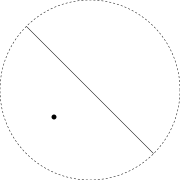Course:Hyperbolic Geometry Fall2008 - Bart
From EscherMath
Jump to navigationJump to search
- Read Hyperbolic Geometry
- Write up solutions to the following questions:
- Draw a Poincaré disk, and draw four geodesics that don't cross.
- Draw a Poincaré disk, and draw four geodesics through the center point.
- Copy the Poincaré disk shown below, and draw three geodesics through the point that don't cross the line shown.

- Draw a Poincaré disk, and draw a triangle with three 5° angles.
- Draw a Poincaré disk, and draw a 90°-5°-5° triangle. (Hint: Put the 90° angle at the center point.)
- Draw a Poincaré disk, and draw a pentagon with five right angles
- Escher used angels and devils in three artworks: Sketch #45 (Angels and Devils), Sphere with Angels and Devils, and Circle Limit IV (Heaven and Hell).
Answer each question for all three artworks:- How many creatures touch at one wingtip?
- How many creatures touch at their feet?
- Each creature is basically a triangle formed by the two wingtips and the feet. From parts a & b, you know how many of these triangles come together at each vertex. What are the corner angles of these triangles?
- What are the angle sums of these triangles?
- What geometry is the artwork based on?
- Which of these Escher artworks are based on hyperbolic geometry?
- Path of Life I
- Circle Limit I
- Circle Limit II
- Circle Limit III
- Verbum
- Development II
- Square Limit
- Snakes
- Rippled Surface
- Find the defect and area of the following hyperbolic polygons:
- A triangle with three 5° angles.
- A 90°-5°-5° triangle.
- A pentagon with five right angles.
- A 90°-0°-0° triangle. What does this triangle look like?
- A 20°-20°-20°-20° quadrilateral.
- Compare Hyperbolic geometry to spherical and Euclidean geometry.
- What can we say about parallel lines in hyperbolic geometry?
- What can we say about the sum of the angles in a triangle?
- Do n-gons exist for all possible values of n?
- Do we have squares and rectangles in hyperbolic geometry? Why or why not?
- Do parallellograms exist in hyperbolic geometry? If so, what do they look like?
- Give an example (sketch) of the isometries: translation, rotation, and reflection.
- How do we measure the defect of a triangle?
- How do we measure the area of a triangle?
- How do we measure the defect of a general polygon?
- How do we measure the area of a general polygon?